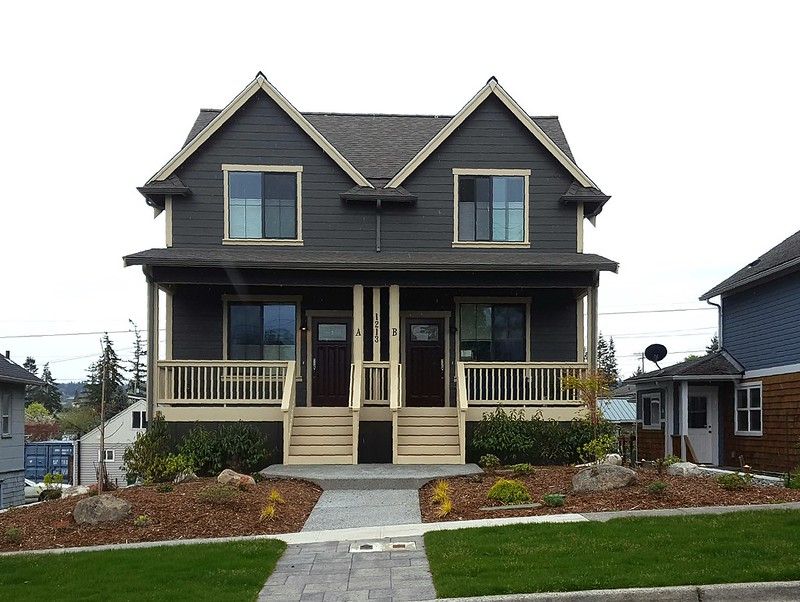Physical Address
304 North Cardinal St.
Dorchester Center, MA 02124
Physical Address
304 North Cardinal St.
Dorchester Center, MA 02124
One common explanation for high rents is something called “financialization.” Literally, this term of course makes no sense: any form of investment, good or bad, involves finances. But I think that the most common non-incoherent use of the term is something like this: rich people and corporations have decided that real estate is a good investment, and are buying it, thus driving up demand and making it more costly. But if this is true, to blame financialization for high rents and sale prices is to confuse cause and effect. If real estate prices weren’t going up, it wouldn’t make sense to buy buildings as investment. Thus, high housing costs cause financialization, not vice versa. In fact, if government did not restrict housing supply through zoning, financialization would be a force for good. Why? Because instead of buying existing buildings, people with money might be more willing to build new buildings for people to live in- which in turn might hold housing costs down. PS I am running for Borough President of Manhattan, and am gradually creating a Youtube page that addresses anti-housing arguments in more detail.

After over a century, Berkeley, California may be about to legalize missing middle housing – and it’s not alone. Bids to re-legalize gradual densification in the form of duplexes, triplexes, fourplexes, and the like have begun to pick up steam over the last several years. In 2019, Oregon legalized these housing types statewide while Minneapolis did the same at the city level. In 2020, Virginia and Maryland both tried to pass similar legislation, though they ultimately failed. This year, though, Montana and California may pick up the torch with their own state bills (even while the cities of Sacramento and South San Francisco consider liberalizing unilaterally alongside Berkeley). Allowing gradual densification is an absolutely necessary step towards general affordability. Supply, demand, and price form an iron triangle–the more responsive we can make supply to demand, the less price will spike to make up the difference.* What I really want to focus on here, though, is less about policy and more about political economy. I believe allowing medium-intensity residential development could make additional reforms easier to achieve and change views around development going into the future. We Love What We Know More often than not, I think a generalized status quo bias explains a lot of NIMBYism. Homeowners are most comfortable with their neighborhoods as they are now and are accustomed to the idea that they have the right to veto any substantial changes. Legalizing forms of incrementally more intense development could re-anchor homeowners on gradual change and development as the norm. The first part of the story is about generational turnover. If the individuals buying homes today–and the cohorts that follow–are exposed to gradually densifying neighborhoods in their day-to-day, they’ll anchor on that as what’s normal and therefore acceptable. Moreover, if we’re debating whether to rezone an area for mid-rise […]

Current events being what they are, I’m happy to be writing about something positive. Once again, we’re getting an ambitious housing reform package in the California legislature. The various bills focus on removing obstacles to new housing and are a sign of the growing momentum Yimby activists have built up over the last few years. The permitting process for new housing in California is the bureaucratic equivalent of American Ninja Warrior. Localities use restrictive zoning and discretionary approvals to block new construction. When faced with state level oversight, California cities have historically leaned on bad faith requirements to ensure theoretically permitted and approved housing remains commercially infeasible. And as if that weren’t enough, “concerned citizens” can use the ever popular CEQA lawsuit to kill projects themselves (independent of direct involvements from electeds). This year’s housing package helps reduce the difficulty of getting a project through the gauntlet. Still an obstacle course, but with a few less water hazards and a slightly shorter warped wall. Still suboptimal, but directionally correct in a very big way. There are several pro-supply bills in the package, but two are especially worth calling out. SB 6 allows for residential development in areas currently zoned for commercial office or retail space. The bill would also create opportunities for streamlined approval if some portion of a proposed project site has been vacant. This last bit seems to be intended to encourage redevelopment of dead malls and similar retail heavy areas that could be better put to use as housing. SB 9 allows for duplexes and lot splits in single family zones by right. This type of missing middle housing could – at least in certain parts of California – be new housing that’s less expensive then existing stock; that’s a great outcome from a policy perspective, but […]
Arlington County policymakers have issued a call for ideas on improving housing availability and affordability. If you’d like to submit your own ideas, you can do so here through the rest of the day. The ideas that I submitted are below. Arlington County is a national model for transit-oriented development. Permitting dense, multifamily housing to be built on the County’s transit corridors has contributed to making the Washington, DC region more affordable compared to other high-income coastal regions. Nonetheless, housing prices in Arlington are high and rising due to increasing demand for access to the job market, schools, and other benefits that Arlington offers. County policymakers have opportunities to reform land use regulations to permit both dense multifamily housing and missing middle housing to improve access to Arlington’s opportunities. Zoning for Transit Oriented Development Ahead of Metro’s arrival in Arlington, county policymakers adopted the well-known “bulls eye approach” to planning, which calls for dense development surrounding the Rosslyn-Ballston corridor Metro stations. This plan calls for dense development to be permitted within one-quarter mile of these stations. Unfortunately, this plan has never been realized in the zoning ordinance. The County maintains single-family or townhouse zoning within one-quarter mile of four stations on this corridor and a relatively low-density multifamily zone within one-quarter mile of the Rosslyn station. The County needs more townhouses and low-rise multifamily housing, but it also needs more high-rise multifamily housing as the bulls eye plan recognized. Given the high and rising land values and house prices along this corridor, it’s past time to realize this decades-old planning objective. Further, planning for urban villages around Metro stations should be extended to the area around the East Falls Church station area, where residents of multifamily housing have to walk past land zoned exclusively for single-family houses to reach the […]
A stickplex is a dense residential structure or group of structures built with inexpensive materials and techniques, most commonly wood. Stickplexes use 2,500 square feet of land per unit or less. Stickplexes have per-square-foot construction costs roughly in line with detached houses due to avoidance of costly features like elevators and more expensive construction methods. This type of housing includes features of both multifamily housing and single-family housing. They economize on land while avoiding the high construction costs of large multifamily buildings. Relative to high-rise housing, stickplexes can cost one-third less to build on a per-square-foot basis. And because they use a relatively small amount of land per unit, their land costs are lower than the typical detached house’s land costs. Stickplexes versus missing middle Daniel Parolek coined the term “missing middle” and emphasizes that missing middle “is compatible in scale with single-family homes.” He advises caution about permitting three-story buildings, while a stickplex can be three stories or taller. A duplex on a 6,000 square foot lot would fit the definition of missing middle. But it would not be a stickplex since it would use more than 3,000 square feet of land per unit. Missing middle housing has found traction politically. Policymakers who have passed zoning reforms from Oregon to Nebraska to Durham have used the term to describe the type of construction they would like to see. Minneapolis Council Member Lisa Goodman described the city’s reform to permit triplexes in language similar to Parolek’s: “I like to refer to it as, ‘the box can’t change,” she said. “All that can change is how many families can live within the existing box.” However, in Minneapolis, questions remain about how feasible triplexes will be to build in permitted building envelopes. Zoning rules, including floor area ratio limits of less than one […]
I had always thought dollar stores were a nice thing to have in an urban neighborhood, but recently they have become controversial. Some cities have tried to limit their growth, based on the theory that “they impede opportunities for grocery stores and other businesses to take root and grow.” This is supposedly a terrible thing because real grocery stores sell fresh vegetables and dollar stores don’t. In other words, anti-dollar store groups believe that people won’t buy nutritious food without state coercion, and that government must therefore drive competing providers of food out of business. Recently, I was at the train stop for Central Islip, Long Island, a low-income, heavily Hispanic community 40 miles from Manhattan. There is a Family Dollar almost across the street from the train stop, and guess what is right next to it, in the very same strip mall? You guessed it- a grocery store! * It seems to me that dollar stores and traditional grocery stores might actually be complementary, rather than competing uses. You can get a lot of non-food items and a few quick snacks at a dollar store, and then get a more varied food selection at the grocery next door. So it seems to me that the widespread villification of dollar stores may not be completely fact-based. Having said that, I’m not ready to say that my theory is right 100 percent of the time. Perhaps in a very small, isolated town (or its urban equivalent), there might be just enough buying power to support a grocery store or a dollar store, but not both. But I suspect that this is a pretty rare scenario in urban neighborhoods. *If you want to see what I saw, go on Google Street View to 54 and 58 E. Suffolk Avenue in Central Islip.

Zoning regulations inflict great harm. But it is difficult for Americans to imagine the cost of zoning in Indian cities. Delhi is one of the most crowded cities in the world, and there is great demand for floor space. But real estate developers are not allowed to build tall buildings.

Elizabeth Warren’s housing bill has received a lot of love from those who favor of land use liberalization. Like Cory Booker’s housing bill, the Warren bill would seek to encourage state and local land use reform using federal grants as an incentive. Warren’s bill would significantly increase funding for the Housing Trust Fund and provide a small increase in allocations for public housing maintenance. However, Warren’s bill also includes new subsidies to homeownership and policies that could reduce the production of new renter-occupied housing relative to owner-occupied housing. There’s a trade off in housing policy between promoting homeownership as a wealth-building tool and promoting affordability that politicians, including Warren, have failed to confront. Rather than promoting housing affordability by rolling back policies that subsidize homeowners at the expense of renters, Warren’s bill seeks to reduce exclusionary, suburban zoning at the same time it introduces new policies to incentivize homeownership. First, Warren’s bill would require most foreclosed homes to be sold to new owner-occupants, rather than to landlords who would rent them out. The intention of the bill is to prevent institutional investors from profiting from foreclosures, but this approach has a strong anti-renter bias. When changes in economic conditions, demographics, or preferences lead to an increase in the proportion of Americans who want to rent rather than own, this policy would stand in the way of homes being adapted to meet new needs. Second, the bill would provide down payment assistance to first-time homebuyers who live in, or were displaced from, historically redlined neighborhoods. All levels of government have played horrific roles in excluding minorities from white neighborhoods and subsidizing wealth-building through home equity for white households alone. The victims of these policies deserve to be compensated for this unfairness. The Justice Department and the Department of Housing and Urban […]
Anti poverty programs have been taking center stage as the 2020 Democratic primary heats up. Proposals from Kamala Harris and Corey Booker target high housing costs for renters and make for an interesting set of ideas. These plans, however, have major shortcomings and fail to address the fundamental problem of supply constraints in high cost housing markets. Harris and Booker on Housing Both the Harris and Booker plans call for direct subsidies to renters via the tax code. Harris’ Rent Relief Act (RRA) is a refundable tax credit for renters making $100,000 or less and spending more than 30% of their income on rent. The credit would be worth a percentage of the delta between the recipient’s rent (capped at 150% of area fair market rent) and 30% of their income. Actual benefits would be bigger or smaller depending on the size of the gap. Booker’s Housing, Opportunity, Mobility, and Equity (HOME) Act is also designed as a refundable tax credit for renters paying more than 30% of their income in rent. Unlike Harris’ RRA, there’s no sliding scale for benefits. The credit covers the entire difference between 30% of the recipients income and their rent (also capped by area fair market rent). Both programs are in the same vein as other democratic anti-poverty proposals which use the tax code to affect transfer payments. The others, though, are expansions of the federal Earned Income Tax Credit (EITC) whereas these two proposals more narrowly target housing. Devils in the Details Housing costs are a major impediment to financial stability for many, so it’s good to see reducing them called out as a poverty reduction strategy. And transfer payments (as opposed direct government provisioning or price fixing) make for better social safety nets. However, as Tyler Cowen points out, juicing the demand side […]

Many readers of this blog know that government subsidizes driving- not just through road spending, but also through land use regulations that make walking and transit use inconvenient and dangerous. Gregory Shill, a professor at the University of Iowa College of Law, has written an excellent new paper that goes even further. Of course, Shill discusses anti-pedestrian regulations such as density limits and minimum parking requirements. But he also discusses government practices that make automobile use far more dangerous and polluting than it has to be. For example, environmental regulations focus on tailpipe emissions, but ignore environmental harm caused by roadbuilding and the automobile manufacturing process. Vehicle safety regulations make cars safer, but American crashworthiness regulations do not consider the safety of pedestrians in automobile/pedestrian crashes. Speeding laws allow very high speeds and are rarely enforced. If you don’t want to read the 100-page article, a more detailed discussion is at Streetsblog.